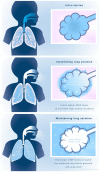Feasibility and Effect of Physiological-Based CPAP in Preterm Infants at Birth
- PMID: 34926350
- PMCID: PMC8678466
- DOI: 10.3389/fped.2021.777614
Feasibility and Effect of Physiological-Based CPAP in Preterm Infants at Birth
Abstract
Background: Preterm infants are commonly supported with 5-8 cmH2O CPAP. However, animal studies demonstrate that high initial CPAP levels (12-15 cmH2O) which are then reduced (termed physiological based (PB)-CPAP), improve lung aeration without adversely affecting cardiovascular function. We investigated the feasibility of PB-CPAP and the effect in preterm infants at birth. Methods: Preterm infants (24-30 weeks gestation) were randomized to PB-CPAP or 5-8 cmH2O CPAP for the first 10 min after birth. PB-CPAP consisted of 15 cmH2O CPAP that was decreased when infants were stabilized (heart rate ≥100 bpm, SpO2 ≥85%, FiO2 ≤ 0.4, spontaneous breathing) to 8 cmH2O with steps of ~2/3 cmH2O/min. Primary outcomes were feasibility and SpO2 in the first 5 min after birth. Secondary outcomes included physiological and breathing parameters and short-term neonatal outcomes. Planned enrollment was 42 infants. Results: The trial was stopped after enrolling 31 infants due to a low inclusion rate and recent changes in the local resuscitation guideline that conflict with the study protocol. Measurements were available for analysis in 28 infants (PB-CPAP n = 8, 5-8 cmH2O n = 20). Protocol deviations in the PB-CPAP group included one infant receiving 3 inflations with 15 cmH2O PEEP and two infants in which CPAP levels were decreased faster than described in the study protocol. In the 5-8 cmH2O CPAP group, three infants received 4, 10, and 12 cmH2O CPAP. During evaluations, caregivers indicated that the current PB-CPAP protocol was difficult to execute. The SpO2 in the first 5 min after birth was not different [61 (49-70) vs. 64 (47-74), p = 0.973]. However, infants receiving PB-CPAP achieved higher heart rates [121 (111-130) vs. 97 (82-119) bpm, p = 0.016] and duration of mask ventilation was shorter [0:42 (0:34-2:22) vs. 2:58 (1:36-6:03) min, p = 0.020]. Infants in the PB-CPAP group required 6:36 (5:49-11:03) min to stabilize, compared to 9:57 (6:58-15:06) min in the 5-8 cmH2O CPAP group (p = 0.256). There were no differences in short-term outcomes. Conclusion: Stabilization of preterm infants with PB-CPAP is feasible but tailoring CPAP appeared challenging. PB-CPAP did not lead to higher SpO2 but increased heart rate and shortened the duration of mask ventilation, which may reflect faster lung aeration.
Keywords: CPAP; birth; physiology; preterm; respiratory support.
Copyright © 2021 Martherus, Kuypers, Böhringer, Dekker, Witlox, Hooper and Pas.
Conflict of interest statement
The authors declare that the research was conducted in the absence of any commercial or financial relationships that could be construed as a potential conflict of interest.
Figures





References
LinkOut - more resources
Full Text Sources

